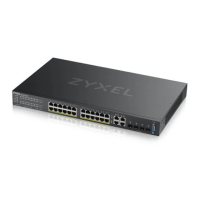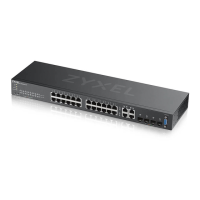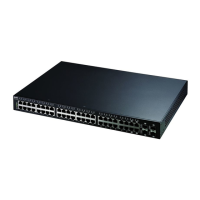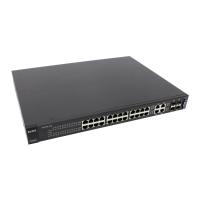Chapter 47 Access Control
GS2220 Series User’s Guide
403
The following table describes the labels in this screen.
47.3.1 Co nfig ure SNMP Tra p G roup
From the SNMP screen, click Tra p G ro up to view the screen as shown. Use the Tra p G ro up screen to
specify the types of SNMP traps that should be sent to each SNMP manager.
Table 211 Management > Access Control > SNMP
LABEL DESC RIPTIO N
General Setting Use this section to specify the SNMP version and community (password) values.
Version Select the SNMP version for the Switch. The SNMP version on the Switch must match the
version on the SNMP manager. Choose SNMP version 2c (v2c ), SNMP version 3 (v3) or both
(v3v2c ).
SNMP version 2c is backwards compatible with SNMP version 1.
Get Community Enter the G e t C o mm unity string, which is the password for the incoming Get- and GetNext-
requests from the management station.
The G e t Co m munity string is only used by SNMP managers using SNMP version 2c or lower.
Set Community Enter the Se t Co m m unity, which is the password for incoming Set- requests from the
management station.
The Se t Co mm unity string is only used by SNMP managers using SNMP version 2c or lower.
Trap Community Enter the Tra p Co m m unity string, which is the password sent with each trap to the SNMP
manager.
The Tra p Co m m unity string is only used by SNMP managers using SNMP version 2c or lower.
Trap Destination Use this section to configure where to send SNMP traps from the Switch.
Version Specify the version of the SNMP trap messages.
IP Enter the IP addresses of up to four managers to send your SNMP traps to.
Port Enter the port number upon which the manager listens for SNMP traps.
Username Enter the user name to be sent to the SNMP manager along with the SNMP v3 trap.
This user name must match an existing account on the Switch (configured in the
Ma na g e me nt > Ac c e ss Co ntrol > SNMP > Use r screen).
Apply Click Ap ply to save your changes to the Switch’s run-time memory. The Switch loses these
changes if it is turned off or loses power, so use the Sa ve link on the top navigation panel to
save your changes to the non-volatile memory when you are done configuring.
Cancel Click Ca nc e l to begin configuring this screen afresh.

